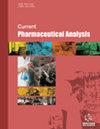Protective Effect of Salvia cadmica on Fibroblast Cells from t-bhp-induced Oxidative Damage
IF 1.5
4区 医学
Q4 PHARMACOLOGY & PHARMACY
引用次数: 0
Abstract
Background:: Salvia species known as "Sage" are among the important aromatic plants used in the world. This study, it was investigated the antioxidant capacity of Salvia cadmica and to investigate its protective effect on oxidative damage in t-BHP-induced fibroblast cells. Methods:: Antioxidant activity and phenolic characterization of the extract were evaluated using DPPH, TPC, TFC, FRAP, and HPLC, respectively.TAS, TOS, MDA and 8-oxo-guanine, CAT, SOD, and GPx values were examined using enzyme-linked immunosorbent assay (ELISA). The antiproliferative and apoptosis effects of Salvia cadmica ethanolic extract were determined using MTT assay and fluorescent probes in fibroblast cells. Results:: As a result of GC-MS analysis of Salvia cadmica ethanolic extract, carvacrol content was found to be high. The IC50 value of the DPPH antioxidant assay of the Salvia cadmica ethanolic extract was 80 ± 0.51 μg/mL. TPC, TFC, and FRAP values were found to be 18.25 ± 0.64 (mg gallic acid/g powder), 1.691±0.314 (mg quercetin /g powder), 31.5 ± 0.10 (mg Trolox/g powder), respectively. Total antioxidant and TOS values were found to be 0.383±0.033 (mmol Trolox Equ L-1), 16.31±0.71 (μmol H2O2 L-1) for 0.25 mg/mL, and 0.725±0.05 (mmol Trolox Equ L-1), 12.02 ±0.56 (μmol H2O2 L-1) for 0.5 mg/mL. In addition, while CAT and GPx significantly decreased enzyme activities, no significant change was observed in SOD enzyme activity. Ethanolic Salvia cadmica extract exhibited apoptotic features compared to only the t-BHP group. Conclusion:: These results suggest that Salvica cadmica extract works through a free radical mechanism.丹参对成纤维细胞免受 t-bhp 诱导的氧化损伤的保护作用
背景介绍被称为 "鼠尾草 "的丹参属植物是世界上常用的重要芳香植物之一。本研究调查了丹参的抗氧化能力,并研究其对 t-BHP 诱导的成纤维细胞氧化损伤的保护作用。方法::采用酶联免疫吸附法(ELISA)检测了丹参提取物的TAS、TOS、MDA和8-氧代鸟嘌呤、CAT、SOD和GPx值。使用 MTT 法和荧光探针测定了丹参乙醇提取物对成纤维细胞的抗增殖和凋亡作用。研究结果丹参乙醇提取物的气相色谱-质谱分析结果表明,丹参酚含量较高。丹参乙醇提取物 DPPH 抗氧化试验的 IC50 值为 80 ± 0.51 μg/mL。TPC 值、TFC 值和 FRAP 值分别为 18.25 ± 0.64(毫克没食子酸/克粉)、1.691±0.314(毫克槲皮素/克粉)和 31.5 ± 0.10(毫克曲安奈德/克粉)。0.25 mg/mL 的总抗氧化值和 TOS 值分别为 0.383±0.033(mmol Trolox Equ L-1)、16.31±0.71(μmol H2O2 L-1);0.5 mg/mL 的总抗氧化值和 TOS 值分别为 0.725±0.05(mmol Trolox Equ L-1)、12.02±0.56(μmol H2O2 L-1)。此外,CAT 和 GPx 的酶活性明显降低,而 SOD 的酶活性没有明显变化。与 t-BHP 组相比,丹参乙醇提取物具有凋亡特征。结论这些结果表明,丹参提取物通过自由基机制发挥作用。
本文章由计算机程序翻译,如有差异,请以英文原文为准。
求助全文
约1分钟内获得全文
求助全文
来源期刊
CiteScore
1.50
自引率
0.00%
发文量
85
审稿时长
3 months
期刊介绍:
Aims & Scope
Current Pharmaceutical Analysis publishes expert reviews and original research articles on all the most recent advances in pharmaceutical and biomedical analysis. All aspects of the field are represented including drug analysis, analytical methodology and instrumentation. The journal is essential to all involved in pharmaceutical, biochemical and clinical analysis.

 求助内容:
求助内容: 应助结果提醒方式:
应助结果提醒方式:


